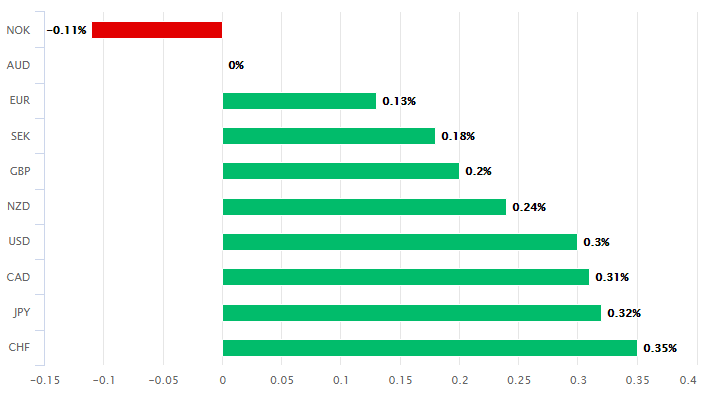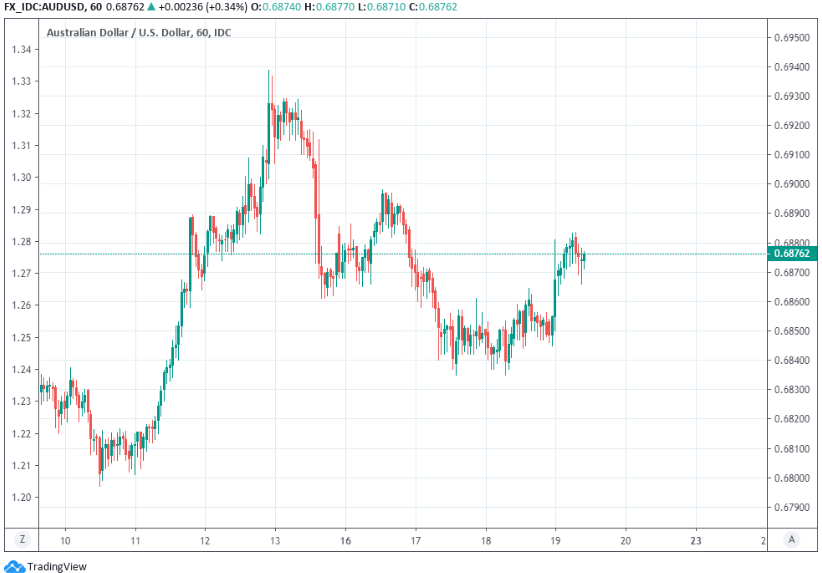The Australian Dollar Rises after Jobs Data Quells Fears of RBA Rate Cuts but Westpac Says It's a Sell
- Written by: James Skinner

Above: Governor Philip Lowe. Photo: O'Neill Photographics/Goldman Sachs. Source: RBA on Flickr, reproduced with permission from the RBA press office.
- AUD advances on major rivals after jobs blowout.
- 39.9k new jobs drive unemployment back to 5.2%
- Easing market concerns over the RBA rate outlook.
- Westpac eyes 2020 slowdown, tips AUD as a sell.
The Australian Dollar rose against all of its major rivals other than the Norwegian Krone Thursday after a blowout jobs report eased market concerns about the outlook for interest rates at the Reserve Bank of Australia (RBA), although Westpac is now tipping the antipodean unit as a sell.
Australia's economy created 39.9k new jobs in November, Australian Bureau of Statistics data revealed, when markets were looking for an increase of only 14.5k. That was enough to drive the unemployment rate back down to 5.2%, from 5.3% in October.
"It is a welcome development and helps to ease concerns over a more material slowdown in the labour market. However, the RBA ideally wants to see the unemployment rate trend lower back towards their NAIRU estimate of around 4.5% to provide more confidence that inflation will return to their target," says Lee Hardman, a currency analyst at MUFG. "Market participants have become less confident that the RBA will deliver two further rate cuts although one is still fully priced for the 1H 2020."

Above: Australian Dollar performance Vs major rivals Thursday. Source: Pound Sterling Live.
Thursday's data is good news for the Aussie Dollar because the RBA has flagged the labour market as the most important driver of its stance on interest rates because of the impact that rising and falling unemployment can have on both wage growth and inflation. The RBA has been seeking to lift Aussie inflation back within the 2%-to-3% target band for years and has cut its cash rate three times in 2019 to that end, leaving it at 0.75%.
Markets had been betting heavily the RBA would cut rates again before April 2020 and on a further occasion by the end of next year until the bank hinted in the opening days of December that it might sit on its hands for a while before doing anything more in order to observe the impact of the three cuts announced so far. That led investors to begin pricing-out the second anticipated cut, although the unwind of those bets was aided last week by the 'phase one deal' agreed between the U.S. and China.

Above: AUD/USD rate shown at hourly intervals.
"The RBA is heading into 2020 too optimistic on Australia’s growth prospects. After the striking weakness in consumer spending in the Q3 GDP report and partial data, we expect the RBA to cut its 2020 growth forecast from 2.8% to a sub-trend 2.5% in the February SoMP," says Richard Franulovich, head of FX strategy at Westpac. "This leaves the door open to the 25bp cash rate cut to 0.5% that we expect. Markets should then fully price a 0.25% terminal rate."
Franulovich and the Westpac team told clients Thursday they should sell the AUD/USD rate if it makes it back up to the 0.6950 level any time soon and target a move back down to 0.670 during the first quarter of next year. Their idea is based upon the expectation that the RBA will cut rates twice more in the year ahead and do nothing to discourage depreciation of the currency.
There was support for that kind of a rate outlook in the minutes of December's RBA policy meeting. They revealed this week that the bank still has clear 'easing bias' despite hinting that it wants to sit on its hands for a while. Policymakers agreed at the meeting that wage growth was "not consistent" in the recent quarter with inflation returning sustainably to the target range and "nor was it consistent" with household spending picking back up to its "trend" level.
Time to move your money? The Global Reach Best Exchange Rate Guarantee offers you competitive rates and maximises your currency transfer. Global Reach can offer great rates, tailored transfers, and market insight to help you choose the best times for you to trade. Speaking to a currency specialist helps you to capitalise on positive market shifts and make the most of your money. Find out more here.
* Advertisement





